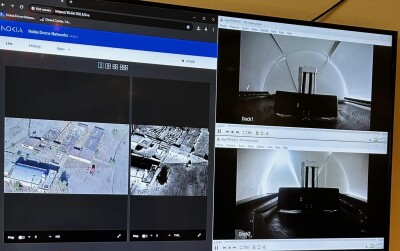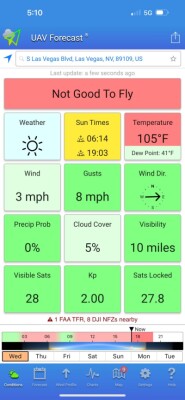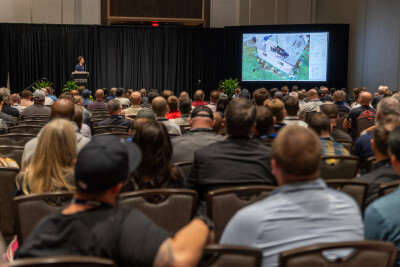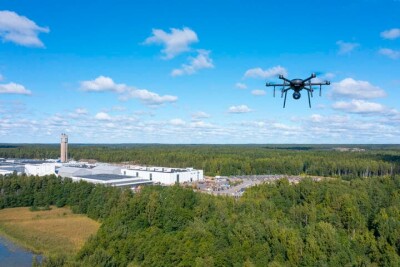For the ninth consecutive year, we made the pilgrimage from Miami, Florida to Las Vegas, Nevada to attend our favorite event of the year: Commercial UAV Expo. As usual, our goal was to look for innovation, but this year we were more interested in novel business models than technological improvements.
The reason is simple. Technologically speaking, the uncrewed aviation industry has reached a certain plateau, which is turning the aircraft into a commodity and not a differentiator. There are still some minor advances in battery technology and useful payload worth mentioning, but the real winners this year were the ones aiming at becoming profitable in the pre-BVLOS era, as opposed to waiting for the Federal Aviation Administration (FAA) to come up with their much-anticipated Notice of Proposed Rulemaking (NPRM), which the federal agency announced will be published before the end of the year.
Two companies in particular caught our attention, Flying Lion and Nokia, which in April announced that they had signed a strategic partnership to enhance the Drones-as-a-Service sector, focusing on public safety and various industries across North America and bringing their solution to the Nevadan desert.
During the event, we had the opportunity to attend a private remote demo of their combined capabilities, and the results were impressive, to say the least.
Barry Brennan, CEO of Flying Lion and Mayank Bhatia, Global Head of Sales – Devices for Nokia, were our hosts, and they masterfully guided us through the different screens showing the various aspects of a flight taking place over 80 miles away in the Nevada desert.
 “What you are looking here today is a live demonstration of the capabilities of our uncrewed platform combined with the strength and reliability of Nokia’s communication technology in some of the most inhospitable flying conditions possible,” Barry said.
“What you are looking here today is a live demonstration of the capabilities of our uncrewed platform combined with the strength and reliability of Nokia’s communication technology in some of the most inhospitable flying conditions possible,” Barry said.
“We’re confident that this collaboration aims to leverage Nokia’s comprehensive Drone Networks to expand 5G-connected uncrewed operations, including beyond visual line of sight capabilities in the North American market,” said Mayank. “We expect this partnership to boost efficiency and reduce costs, significantly benefiting the market in general and our customers in particular.”
With a temperature of 105o F and winds of three to eight knots, the conditions were brutal for any aircraft, but in this case, we were looking at a remote flight conducted from a Las Vegas hotel  to a sophisticated and air-conditioned drone-in-a-box device placed in a remote mining post 80 miles away.
to a sophisticated and air-conditioned drone-in-a-box device placed in a remote mining post 80 miles away.
“The reason why we are using this abandoned small city in the middle of nowhere is to replicate the conditions that law enforcement will face when confronted with an emergency,” Barry said, “With Nokia’s sophisticated drone-in-a-box and communications capabilities and our drone designed with first responders in mind, we have streamlined the process of responding to emergencies.”
The demo consisted in replicating a call that required the drone to take off from an air-conditioned box placed in a remote location to simulate a functioning metropolis in which law enforcement will be faced with the typical obstacles and challenges of any city. The drone took off very fast and, in no time, we had a clear view of the houses and the intended target.
“We can select from a variety of sensors, including traditional imagery and thermal to facilitate night searches,” Barry emphasized. “This creates a new business model of drones-as-a-service that would benefit first responders by providing them with a solution made in the USA in association with a reputable Finnish company such as Nokia.”
Nokia’s turnkey Drone-in-a-box solution is the first FCC-certified 5G-connected drone and the Flying Lion – Nokia solution partnership is a remarkable package that solves multiple issues which law enforcement and other industries face when selecting an uncrewed aviation platform that is required to solve more than one problem at a time.
“Nokia is focused on Public Safety, & Emergency Services, Energy and Utility, Oil & Gas, Mining, Infrastructure and Transport to list a few Industry sectors,” Mayank said, “Nokia just partnered with Swisscom Broadcast to deploy a nationwide Drones-as-a-Service network across Switzerland. 300 Nokia Drone-in-a-Box units are planned for deployment to enable emergency response, perimeter protection and infrastructure inspection, which will help keep public safety workers safe.”
These are all welcome news in the USA as we balance the need for more uncrewed aviation in law enforcement and first responders, with the limitations to use certain platforms in organizations that benefit from federal funding. We expect more European companies to seize the opportunity to supply the American market with public safety solutions and we look forward to more competition and better prices.















Comments